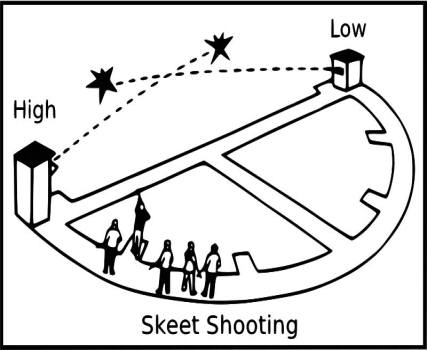Basic HTML Version






26
SportGlobe
December 5-11, 2012
Email: sportglobe2005@yahoo.com
S
mith & Wesson’s M&P (military & police) pistols may very
well be the next generation of top-class polymer pistols, based
on its reliability, accuracy,
serviceability and ergonomics.
The pistol frame is made out
of Zytel polymer reinforced
with a stainless steel chassis.
The slide and barrel are made
out of stainless-steel that,
after ‘through hardening’, is
treated with a proprietary-
nitriding process called melonite, which produces a matte gray non-
glare surface.
To improve durability and reliability, the slide rails of the M&P
are thicker than those on many other brands of pistols. M&P bar-
rels have so-called ‘cone’ muzzles.
This style of barrel provides consistent positioning for enhanced
accuracy but, at the same time, produces less friction as the slide
travels rearward.
At the rear top of the barrel is a half-moon cut that allows the
shooter to verify whether there is a cartridge in the chamber.
The extractor’s generously sized claw ensures reliable extraction,
and its external location makes repair and replacement fast and
simple. M&P Pistols come standard with Novak LoMount sights,
one of the most highly regarded sighting arrangements on the mar-
ket today.
These use the three-dot system to aid in rapid sight alignment
and enhanced target acquisition.
For those persons or agencies desiring higher-tech equipment,
Trijicon night sights are optional.
NOVAK SIGHTS
Another nice feature is that all edges of the slide, including the
Novak sights, have been beveled to prevent abrasion to the shoot-
er’s hands when loading and unloading.
While the top of the M&P is impressive, it is the design of the
frame that really sets it apart
from the competition.
Picking up an M&P you
immediately notice its
styling and ergonomics.
Unlike other brands of polymer-frame
pistols, the M&P’s frame features an
extended beavertail that secures the pistol in the
shooter’s hand, dissipates recoil pulse, and lets you
get back on target faster.
An optimal grip angle of 18 degrees makes for a natu-
rally pointing pistol with enhanced recoil control. Last, the trigger
guard is enlarged to allow use by shooters wearing gloves.
One of the more innovative features of the M&P’s frame is in the
grip. Instead of the shooter having to adapt their grip to the pistol,
the pistol’s grip can be adapted to the shooter’s hand by installing
any one of three different sizes (large, medium, and small) of palm
wells at the rear of the grip frame.
To do so, one merely rotates a catch at the bottom of the grip
frame and pulls it out allowing the palm well to be lifted off and
replaced.
The frame of the M&P has a slide-release lever on each side. The
magazine drops free when the magazine release is pressed. The
firearm features an ambidextrous slide stop and reversible maga-
zine release for either right- or left-hand operation.
The M&P uses a double-action-only trigger that provides a 6.5-
pound trigger stroke of 0.30 inches, which completely retracts the
striker before tripping the sear. The trigger pull is exactly the same
for each shot, providing the legendary consistency and accuracy of
a double-action revolver.
Another nice touch is a trigger over-travel stop that eliminates
over-travel after the trigger trips the sear, which reduces the likeli-
hood of flinching, and thus enhances accuracy.
Ultimately, the choice is yours, see you next week.
Smith & Wesson’s M&P
TOP-CLASS
POLYMER
Bull’s
Eye
Harry
HARRY CHIN-HING
S
keet shoot ing was invented by
William Harden Foster, an avid bird
shooter in the 1920s. Back then, it
was called clock shooting!
The original course was a cir-
cle, marked off like the face of a
clock, with a trap set at the 12
o’clock position.
The practice of shooting clay
targets from al l directions
became very popular, even in
those early days, and evolved
into shooting the semi-circular
course which we know today as skeet shooting!
From its earliest days, the sport was used by
the American military to teach gunners the prin-
ciple of leading and timing, to shoot a target accu-
rately!
The game is meant to simulate the action of
bird hunting. The shooter shoots from seven posi-
tions on a semi-circle with a radius of 21 yards
and an eighth position halfway between stations
one and two.
HIGH HOUSE
There are two houses that hold devices known
as ‘traps’ that launch the targets, one at each cor-
ner of the semi-circle.
The traps launch the targets 15 feet above the
ground.
The ‘high house’ launches targets from 10 feet
and the ‘low house’ sends targets from a trap at
three feet above ground.
At stations one and two, the shooter shoots at
single targets launched from the high house, then
at the low house. Then he shoots a double, where
he shoots at the high target first.
At stations three, four and five, the shooter
attempts single targets launched from the high
house and then from the low-house.
At stations six and seven, the shooter has to
attempt single targets from the high house, then
the low house, and then he shoots
a double, shooting the low target
first and the high house next!
COMPLICATED
At station eight, it’s one high
and then a low target. The shoot-
er must retry his first missed tar-
get or, if there is no missed target, he shoots the
25th target as a repeat of low eight.
What a complicated set of arrangements!
If you are anything like me, your head will be
spinning!! Why even consider skeet shooting?
The firearm of choice is usually a high-quality,
double-barreled, over-and-under shotgun with
26-30” barrels and very open chokes.
Often shooters will choose an improved cylinder
choke (one with a tighter pattern) or a skeet
choke (with a wider pattern), but this is a matter
of preference.
Many successful skeet shooters use semi-auto-
matic shotguns with longer barrels of up to 32”.
Tony Kelly, founder of the Jamaica Skeet Club
won many skeet championships at world champi-
onship level and was inducted in the National
Skeet Shooting Association Hall Of Fame in the
United States.
As your Clay Pigeon, I only want to share with
you the complete addiction that I observe in the
persons I have known to have taken up this sport!
I have watched them for many years, and they
love it!
Try it and tell me.
Addicted to skeet!
Clay
Pigeon
NICOLA AZAN
Tell us what you think. Email: sportglobe2005@yahoo.com

